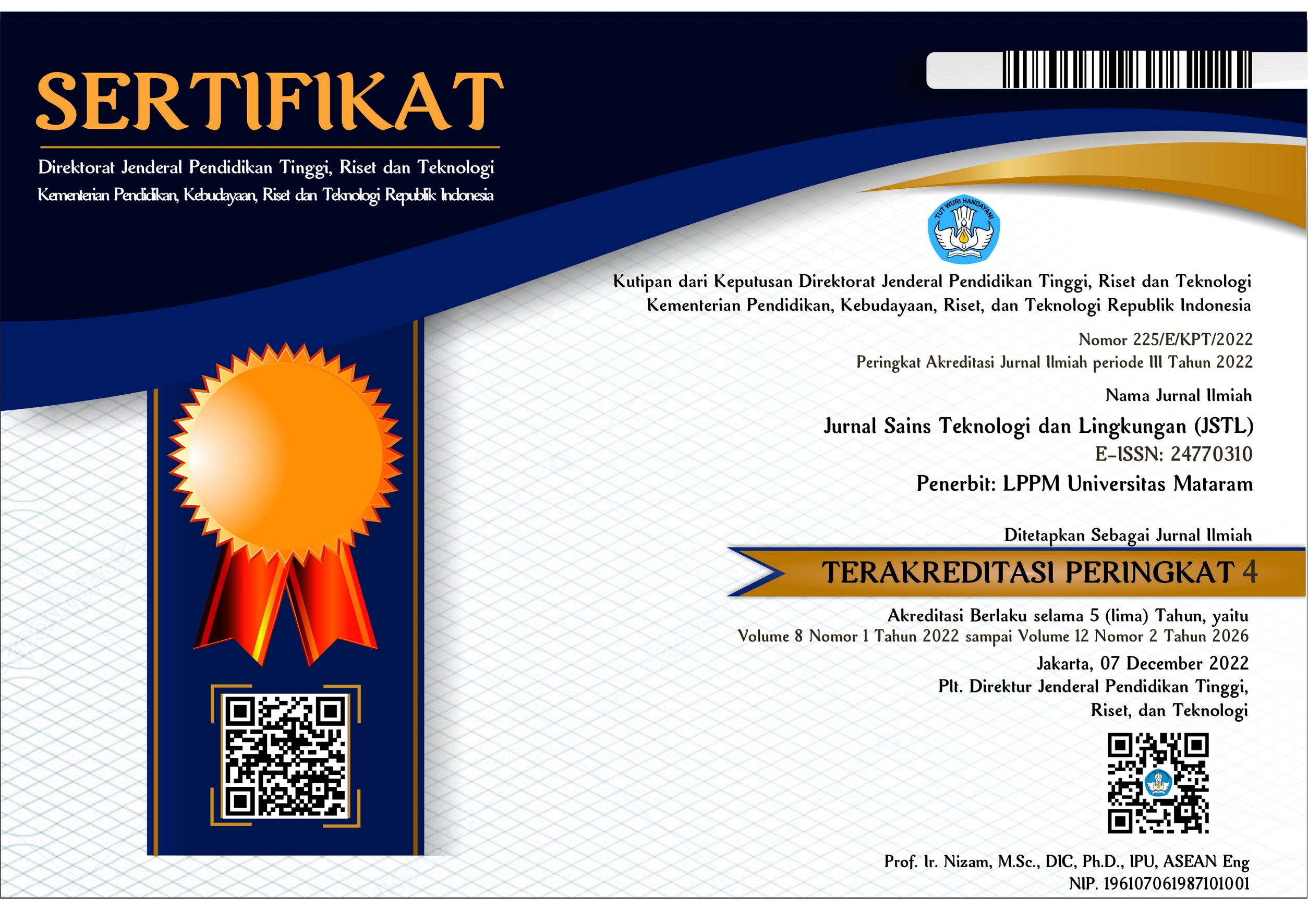Perkembangan Pakan Lobster Berkelanjutan: Tinjauan Nutrisi, Binder, dan Dampak Lingkungan
DOI:
https://doi.org/10.29303/jstl.v11i2.867Keywords:
Lobster feed formulation, Feed binders, Species-specific nutrition, Sustainable aquaculture, Feed efficiencyAbstract
Lobster aquaculture has emerged as a strategic global sector, yet faces critical challenges in sustainable and cost-effective feed formulation. This review synthesizes findings from 15 studies (2004–2025) to analyze species-specific nutritional requirements, binder efficacy, and innovation opportunities. Lobsters require high protein (>45%) for growth (especially larvae/juveniles), with limited lipids (<10%) and moderate carbohydrates (20–35%). Nutritional imbalances reduce feed efficiency and may trigger physiological disorders. Binders like carrageenan (2–4%) and sodium alginate (3%) optimize feed stability (>4 hours) and growth performance (Panulirus argus, Homarus gammarus), while natural binders (e.g., 5% cornmeal) show inferior results. Key challenges include species-specific dietary adaptations (P. cygnus thrives on natural diets), environmental impacts of nitrogen waste, and underutilized local ingredients (e.g., shrimp waste meal). The study highlights the potential of multifunctional binders, RAS/IMTA systems, and fishery byproduct-based feeds. A holistic approach integrating precision nutrition, innovative feed technologies, and sustainable farming practices is recommended to enhance productivity and environmental sustainability. Future research should prioritize binder-microbiome interactions, standardized protocols for commercial species, and circular economy models to support Indonesia’s competitive position in global lobster markets.References
Amin, M., Taha, H., Samara, S. H., Fitria, A., Muslichah, N. A., Musdalifah, L., ... & Arai, T. (2022). Revealing diets of wild-caught ornate spiny lobster, Panulirus ornatus, at puerulus, post-puerulus and juvenile stages using environmental DNA (eDNA) metabarcoding. Aquaculture Reports, 27, 101361.
Bourne, D. G., Young, N., Webster, N., Payne, M., Salmon, M., Demel, S., & Hall, M. (2004). Microbial community dynamics in a larval aquaculture system of the tropical rock lobster, Panulirus ornatus. Aquaculture, *242*(1–4), 31–51.
Clarke, L. J., Griffin, R. A., Domoney, E., Smith, H. C. M., Tilsley, L. J., Ellis, C., ... & Daniels, C. L. (2023). Low-impact rearing of a commercially valuable shellfish: Sea-based container culture of European lobster Homarus gammarus in the United Kingdom. Aquaculture Environment Interactions, 15, 215–230.
Crear, B. J., Thomas, C. W., Hart, P. R., & Carter, C. G. (2000). Growth of juvenile southern rock lobsters, Jasus edwardsii, is influenced by diet and temperature, whilst survival is influenced by diet and tank environment. Aquaculture, 190 (1–2), 169–182.
Edwards, T. M., Puglis, H. J., Kent, D. B., Durán, J. L., Bradshaw, L. M., & Farag, A. M. (2024). Ammonia and aquatic ecosystems – A review of global sources, biogeochemical cycling, and effects on fish. Science of the Total Environment, 907, 167911.
Food and Agriculture Organization (FAO). (2024). The state of world fisheries and aquaculture 2024 – Blue transformation in action. Rome.
Gonçalves, R., Gesto, M., Teodósio, M. A., Baptista, V., Navarro-Guillén, C., & Lund, I. (2021). Replacement of Antarctic krill (Euphausia superba) by extruded feeds with different proximate composition: Effects on growth, nutritional condition, and digestive capacity of juvenile European lobsters (Homarus gammarus, L.). Journal of Nutritional Science, 10, e1.
Gonçalves, R., Lund, I., Gesto, M., & Skov, P. V. (2020). The effect of dietary protein, lipid, and carbohydrate levels on the performance, metabolic rate and nitrogen retention in juvenile European lobster (Homarus gammarus, L.). Aquaculture, 525, 735334.
Gonçalves, R., Gesto, M., Rodríguez, C., Reis, D. B., Pérez, J. A., & Lund, I. (2022). Ontogenetic changes in digestive enzyme activity and biochemical indices of larval and postlarval European lobster (Homarus gammarus, L.). Marine Biology, 169 (5), 53.
Hinchcliffe, J., Agnalt, A. L., Daniels, C. L., Drengstig, A. R., Lund, I., McMinn, J., & Powell, A. (2022). European lobster Homarus gammarus aquaculture: Technical developments, opportunities and requirements. Reviews in Aquaculture, 14 (2), 919–937.
Hinchcliffe, J., Powell, A., Langeland, M., Vidakovic, A., Undeland, I., Sundell, K., & Eriksson, S. P. (2020). Comparative survival and growth performance of European lobster Homarus gammarus post-larva reared on novel feeds. Aquaculture Research, 51 (1), 102–113.
Johnston, D., Melville-Smith, R., & Hendriks, B. (2007). Survival and growth of western rock lobster Panulirus cygnus (George) fed formulated diets with and without fresh mussel supplement. Aquaculture, 273 (1), 108–117.
Jones, C. M., Le Anh, T., & Priyambodo, B. (2019). Lobster aquaculture development in Vietnam and Indonesia. In Lobsters: Biology, fisheries and aquaculture (pp. 541–570). Springer.
Lund, I. (2025). Influence of phospholipid and LC-PUFA content in extruded micro diets on European lobster larval (Homarus gammarus) performance and nutritional composition. Fisheries Research, 281, 107255.
Ly, N. T. Y. (2009). Economic analysis of the environmental impact on marine cage lobster aquaculture in Vietnam [Master’s thesis, Universitetet i Tromsø].
Perera, E., Fraga, I., Carrillo, O., Díaz-Iglesias, E., Cruz, R., Báez, M., & Galich, G. S. (2005). Evaluation of practical diets for the Caribbean spiny lobster Panulirus argus (Latreille, 1804): Effects of protein sources on substrate metabolism and digestive proteases. Aquaculture, 244 (1–4), 251–262.
Perera, E., & Simon, C. (2015). Digestive physiology of spiny lobsters: Implications for formulated diet development. Reviews in Aquaculture, 7 (4), 243–261.
Powell, A., Hinchcliffe, J., Sundell, K., Carlsson, N. G., & Eriksson, S. P. (2017). Comparative survival and growth performance of European lobster larvae, Homarus gammarus, reared on dry feed and conspecifics. Aquaculture Research, 48 (10), 5300–5310.
Saleela, K. N., Soman, B., & Palavesam, A. (2015). Effects of binders on stability and palatability of formulated dry compounded diets for spiny lobster Panulirus homarus (Linnaeus, 1758). Indian Journal of Fisheries, 62 (1), 95–100.
Simon, C. J. (2009). Digestive enzyme response to natural and formulated diets in cultured juvenile spiny lobster, Jasus edwardsii. Aquaculture, 294 (3–4), 271–281.
van Putten, I. E., Farmery, A. K., Green, B. S., Hobday, A. J., Lim‐Camacho, L., Norman‐López, A., & Parker, R. W. (2016). The environmental impact of two Australian rock lobster fishery supply chains under a changing climate. Journal of Industrial Ecology, 20(6), 1384–1398.
Downloads
Published
Issue
Section
License

This work is licensed under a Creative Commons Attribution-NonCommercial-ShareAlike 4.0 International License.


1.png)











